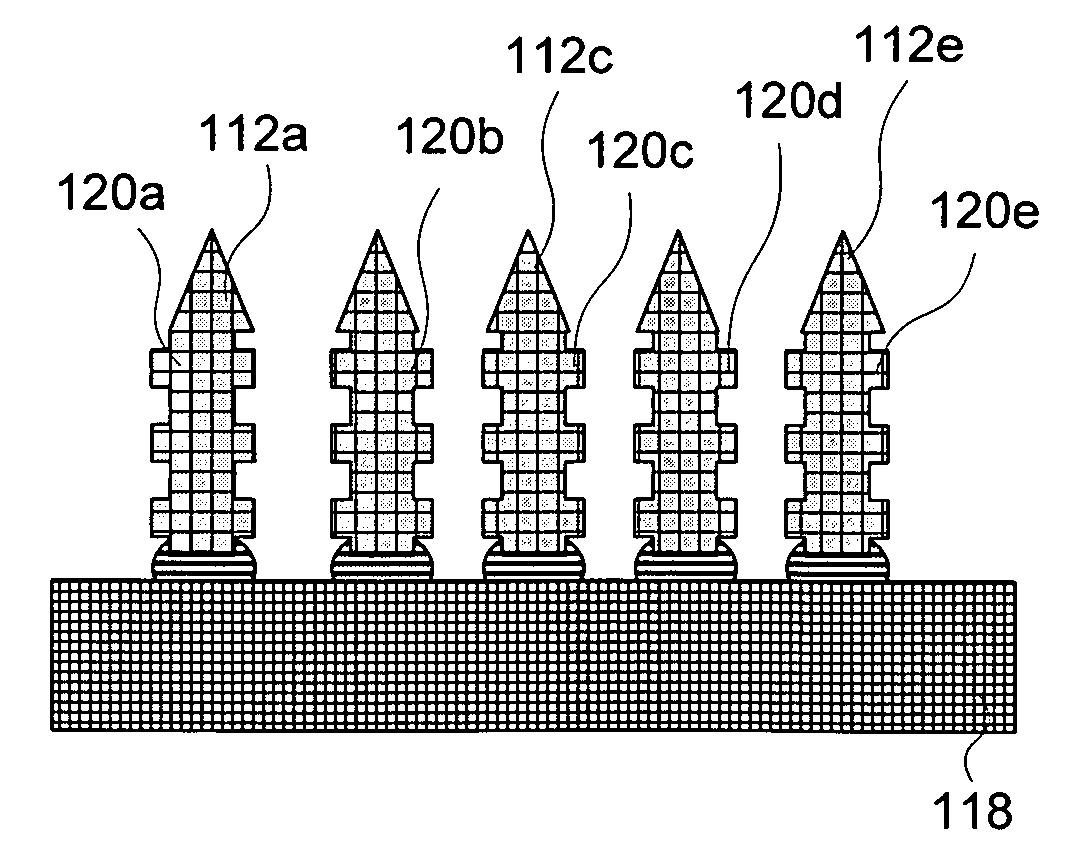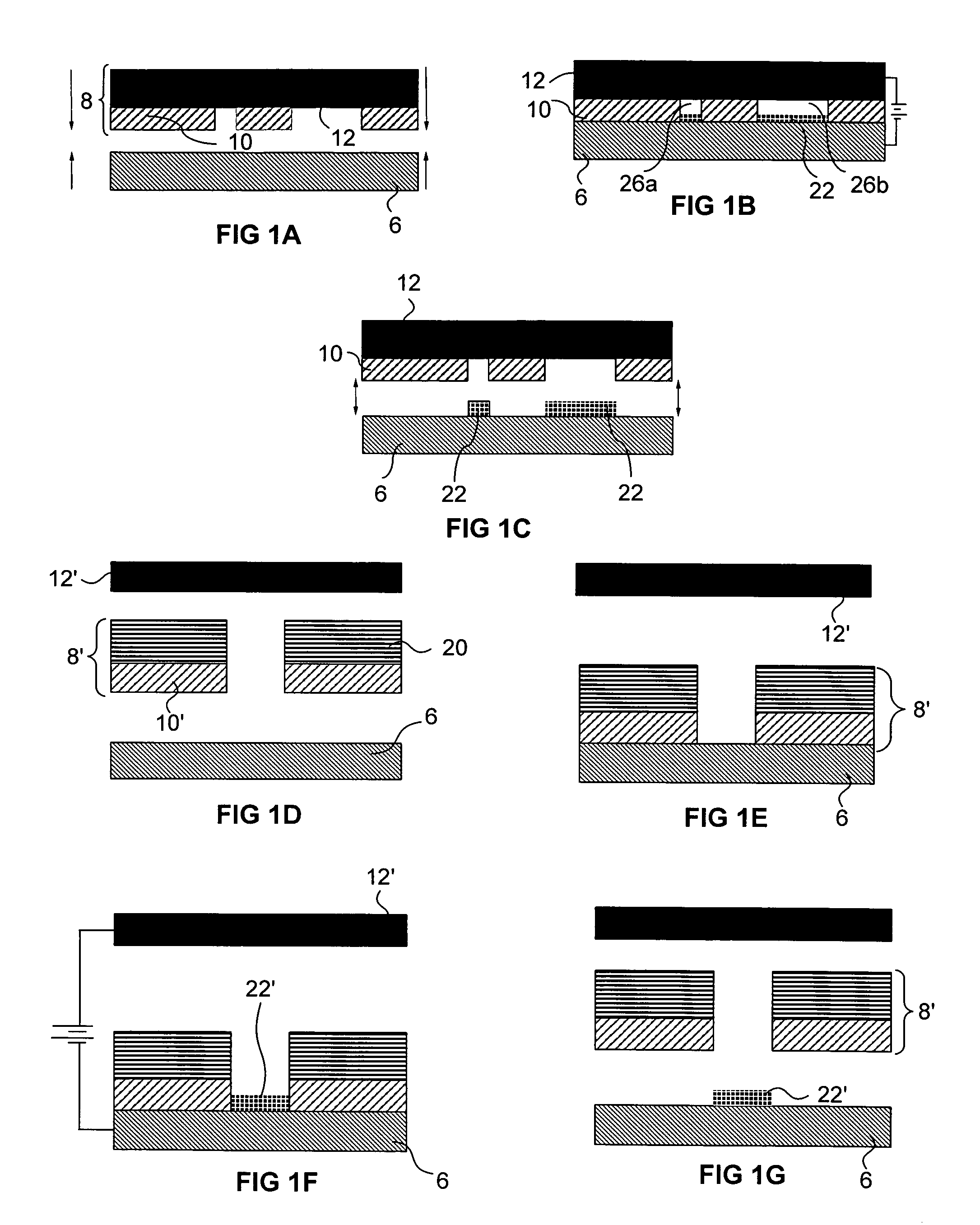Microprobe tips and methods for making
a technology of microprobes and tips, applied in the field of microprobes, can solve the problems of destructive separation of masking materials from substrates, and achieve the effect of reducing the risk of contamination
- Summary
- Abstract
- Description
- Claims
- Application Information
AI Technical Summary
Benefits of technology
Problems solved by technology
Method used
Image
Examples
first embodiment
[0098]FIGS. 5A-5J schematically depict side views at various stages in an example of the process for forming an array of probe elements according to the invention where the probe element tips are formed via electroplating onto a seed layer coated epoxy template which was molded from a silicon wafer that underwent patterned anisotropic etching.
[0099]FIG. 5A depicts the state of the process after a patterned silicon wafer 102 is supplied. The silicon wafer has been patterned by placing a mask over its surface and patterning the mask to have openings in regions that correspond to desired probe tip locations. While the mask is in place an isotropic etching is preformed to create V-shaped or conically shaped holes 104 in the silicon.
[0100]In alternative embodiments these openings may take the form of V-shaped trenches where it is desired that probe tips take such a form. The openings 104 in silicon 102 correspond to desired probe tip locations and represent the compliment of the probe ti...
third embodiment
[0121]FIGS. 7A-7F schematically depict side views at various stages in an example of a process for forming a probe element according to the invention where the probe element tip is formed using a protrusion of patterned photoresist that is made to have an undercut.
[0122]FIG. 7A depicts the state of the process where a temporary substrate 182 is coated with a negative photoresist material 184, e.g. Futurrex NR9-8000 (Futurrex, Inc. of Franklin, N.J.). Located above the photoresist material is a photomask 186 which has one or more openings 190 through which radiation 188 may be directed to expose the photoresist material. Openings 190 correspond to locations where probe element tip material 192 will eventually be located on substrate 182.
[0123]FIG. 7B depicts the state of the process after substrate 182 and photoresist 184 have been immersed in a developing solution 194 such that unexposed portions of photoresist 184 are removed and such that exposed region 184a remains.
[0124]FIG. 7C ...
fourth embodiment
[0130]FIGS. 8A-8F schematically depict side views at various stages in an example of a process for forming a probe element according to the invention where the probe element tip is formed using an indentation in a patterned photoresist that is made to have sidewalls that taper outward.
[0131]FIG. 8A depicts the state of the process after a temporary substrate 212 is coated with a positive photoresist 214 and a mask 216 with one or more openings 218 (one is shown) positioned above the photoresist. Radiation 220 is allowed to expose the photoresist in hole regions 218.
[0132]FIG. 8B depicts the state of the process after exposed photoresist 214 is developed and then overdeveloped to yield opening or openings 222 (one is shown) having tapered side walls 224.
[0133]FIG. 8C depicts the state of the process after a probe element tip material 226 is deposited into opening 222 of photoresist 214 and then photoresist 214 is removed.
[0134]FIG. 8D depicts the state of the process after a sacrific...
PUM
| Property | Measurement | Unit |
|---|---|---|
| angle | aaaaa | aaaaa |
| thickness | aaaaa | aaaaa |
| shape | aaaaa | aaaaa |
Abstract
Description
Claims
Application Information
 Login to View More
Login to View More - R&D
- Intellectual Property
- Life Sciences
- Materials
- Tech Scout
- Unparalleled Data Quality
- Higher Quality Content
- 60% Fewer Hallucinations
Browse by: Latest US Patents, China's latest patents, Technical Efficacy Thesaurus, Application Domain, Technology Topic, Popular Technical Reports.
© 2025 PatSnap. All rights reserved.Legal|Privacy policy|Modern Slavery Act Transparency Statement|Sitemap|About US| Contact US: help@patsnap.com



